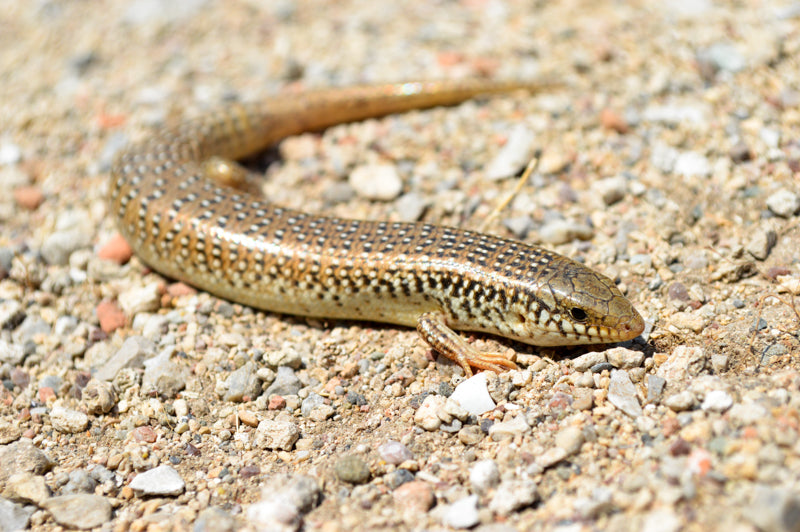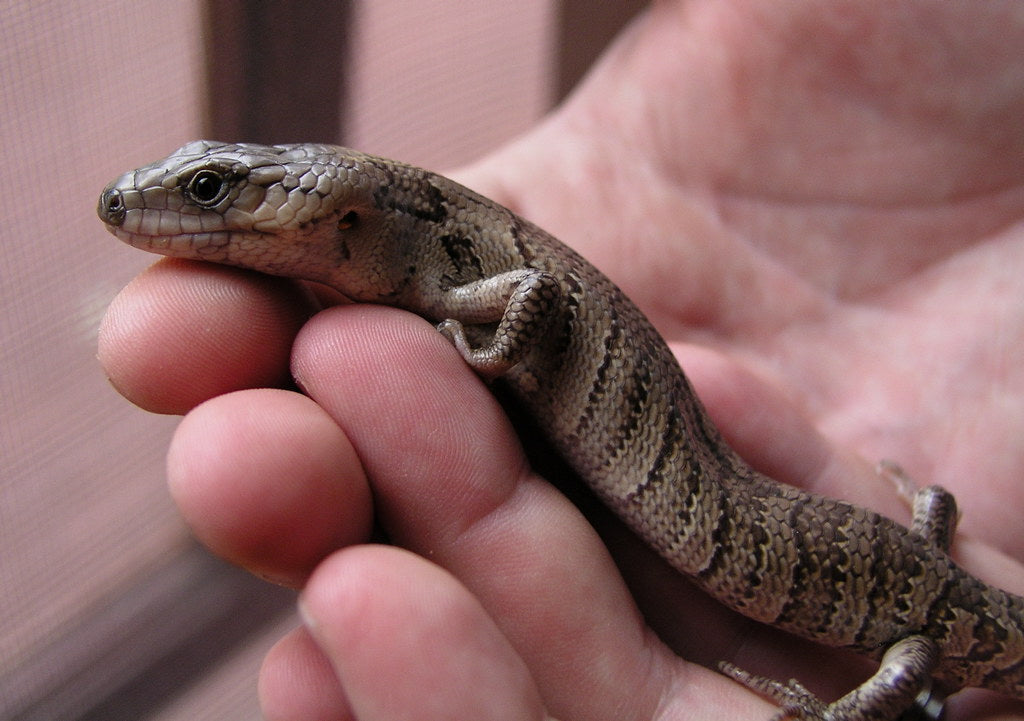Ocellated skinks (Chalcides ocellatus) are small, diurnal, terrestrial lizards native to the Mediterranean coast and coastal areas of the Arabian peninsula. They tend to prefer arid habitats with sandy soil and sparse vegetation.
Ocellated skinks generally grow 7-9” long, with a typical skink body shape of a triangular head, long, cylindrical body, short limbs, and tapered tail. They typically have a tan base color with black ocelli markings with white centers, and a pale belly.
Ocellated skinks are beginner-level pets with bold, entertaining personalities, but they are not the best choice for someone looking for a pet that will tolerate regular handling.
How much space do ocellated skinks need?
A single ocellated skink should be housed in no smaller than a 20 gallon (30” x 12” x 12”) terrarium. Of course, larger is likely to be used if provided, and highly recommended as one way to increase your pet’s quality of life in captivity.
Cohabitation (keeping multiple ocellated skinks in the same terrarium) is not recommended unless the sex of each skink has been confirmed. Ocellated skinks are live-bearers rather than egg-layers, so it can be difficult to control their population in a group setting.
Do ocellated skinks need UVB?
Ocellated skinks are diurnal, which means that they are most active during the day. This means that high-quality UVB lighting is a requirement for keeping them healthy in captivity. Aside from helping provide a day/night cycle, UVB is also good for your skink’s overall wellbeing.
The best UVB bulbs for ocellated skinks are:
- Arcadia T5 HO Forest 6%
- Zoo Med T5 HO Reptisun 5.0
The UVB bulb should be roughly half the length of the enclosure and housed in an Arcadia or Vivarium Electronics fixture with a reflector. Place the fixture on the basking side along with the heat lamp. If the lamp is placed over mesh, then it should be 9-11” above the basking surface. If not obstructed by mesh, then it should be 12-14” above the basking surface.
UVB is blocked by glass and plastic, so you can’t give your skink UVB by placing its terrarium in front of an open window. This can also make your enclosure dangerously hot by creating a greenhouse effect! Also make sure that the fixture your UVB bulb is in does not have a clear plastic or glass bulb cover.
Lights should be on for 14 hours/day during winter, and 10 hours/day during summer to simulate seasonal changes in day length.
What basking temperatures do ocellated skinks need?
Ocellated skinks should have a basking surface temperature of 110-120°F, as measured by an infrared temperature gun pointed at the substrate or stone directly under the heat lamp. There should also be a cooler area on the opposite side of the enclosure that stays between 75-85°F.
It’s best practice to provide heat for your skink with a low-wattage halogen heat lamp. This should be housed in a ceramic-socket dome fixture and placed on one side of the enclosure, next to the UVB lamp. If it's too warm, try a plug-in lamp dimmer — the air of the basking area should not get above 100°F. If it's too cool, you need a higher-wattage bulb. Do not use ceramic heat emitters (CHEs), red bulbs, or blue bulbs, as these are not as effective.
Heat sources should be turned off at night.
What humidity levels do ocellated skinks need?
Ocellated skinks need low humidity (15-35%) during the day and high humidity (90-100%) at night for best health. Use a digital probe hygrometer with the probe in the middle of the terrarium to measure humidity levels.
To increase humidity at night you can either mist the enclosure with a pressure sprayer each evening, or you can set a timer to turn on a fogger each night for a few hours.
What substrate is good for ocellated skinks?
Substrate covers the floor of your skink’s terrarium and helps make the enclosure more attractive, but it also cushions your skink’s body and provides something for them to dig in. It’s ideal to use a substrate that imitates the “substrate” that the reptile naturally lives on in the wild. For ocellated skinks, that means sand or sandy soil.
We recommend the following substrates for ocellated skinks:
- Zoo Med ReptiSand
- Exo Terra Desert Sand
Substrate should be 4” deep and completely replaced every 3-4 months. Remove poop and urates daily, along with contaminated substrate.
What décor can you use in an ocellated skink terrarium?
It’s terribly boring (and stressful!) for a lizard to be stuck in an enclosure with nothing in it except substrate and food/water bowls. It doesn’t matter how big the enclosure is if you don’t put things in it for your pet to use and interact with.
Here are some ideas:
- small logs and branches
- stacks of flat rocks
- ledges
- additional hides
- live or artificial plants
It’s best practice to cover three sides of the enclosure to help the skink feel more secure in its environment!
What do ocellated skinks eat?
Ocellated skinks are primarily insectivorous, which means that they need to eat insects (live) in order to get the nutrition that their bodies need.
How often and how much they need to eat depends on age:
- Juveniles — daily
- Adults — 2-3x/week
- Pregnant and postpartum females — daily
Offer as many insects as they can eat in a 5-minute period.
Feeder insects for ocellated skinks: dubias, discoids, red head roaches, crickets, black soldier fly larvae, mealworms, darkling beetles
Ocellated skinks may also accept treats of finely chopped greens, vegetables, or fruit up to 2x/week.
Supplements
You will need calcium and vitamin supplements to help prevent your lizard from developing a deficiency. We recommend Repashy Calcium Plus LoD, lightly dusted on all of your lizard’s feeder insects. It’s okay to skip a dusting every once in a while.
Water
Provide a small water bowl where your lizard can always get a drink when needed. Change the water daily and scrub the bowl with a reptile-safe disinfectant weekly, or whenever it becomes soiled.
Do ocellated skinks like to be handled?
Few reptiles actually “like” to be held, and ocellated skinks are generally too fast and slippery to be very handleable. Fortunately, it’s really fun to watch these skinks hunt for insects, and they readily take to be tong-fed — or even taking treats from your hand!
*This care sheet contains only very basic information. Although it’s a good introduction, please do further research with high-quality sources to obtain additional information on caring for this species. Here are some other great sources to read:
"File:Kalaentzis - Ocellated Skink, Rhodes.jpg" by Konstakal is licensed under CC BY-SA 4.0




Leave a comment
This site is protected by hCaptcha and the hCaptcha Privacy Policy and Terms of Service apply.